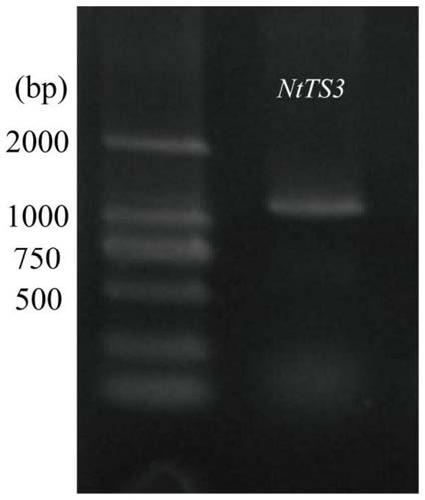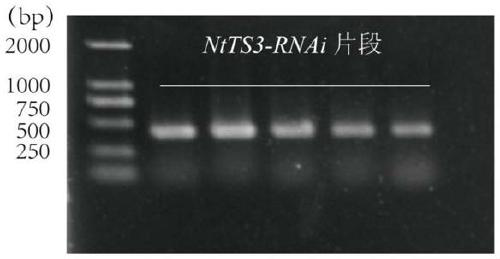Application of tobacco ntts3 gene in controlling tobacco leaf senescence
A leaf aging and genetic technology, applied in the field of genetic engineering, can solve the problems of unfavorable links and late maturity of flue-cured tobacco, and achieve the effect of delaying aging and efficiently controlling the aging process
- Summary
- Abstract
- Description
- Claims
- Application Information
AI Technical Summary
Problems solved by technology
Method used
Image
Examples
Embodiment 1
[0038] Cloning of NtTS3 gene
[0039] 1. Design NtTS3 gene amplification primers containing Gateway adapter
[0040] In this step, in order to connect the primers to the overexpression vector through the gateway recombination technique, the forward and reverse primers used here are both specific and can specifically clone the NtTS3 gene, and a gateway system is added to both ends of the primer The necessary part of the adapter can be amplified by nested PCR in the next step to obtain the NtTS3 gene containing the gateway recombination adapter. The specific method is as follows: the first forward primer (NtTS3-gatewayF) SEQ ID NO.1:
[0041] TACAA AAAAG CAGGC TTC AT GATGA TCGGA GAGAG AAACC;
[0042] The first reverse primer (NtTS3-gatewayR) SEQ ID NO.2:
[0043] GTACA AGAAA GCTGG GTC CT GGATC AGTTC AGAGA TCCA;
[0044] 2. Extract the RNA of Safflower Dajinyuan leaves (the main cultivated tobacco variety) and reverse transcribe it into cDNA, use this as a template, use th...
Embodiment 2
[0078] Acquisition of NtTS3 Gene RNAi Vector
[0079] 1. Design NtTS3-RNAi gene amplification primers containing Gateway adapter
[0080] In this step, in order to connect the primers to the overexpression vector through gateway recombination technology, the pair of primers can specifically amplify the RNAi fragment used for the NtTS3 gene, and part of the gateway linker is added to both ends of the pair of primers, which can pass through the nest The RNAi fragments directly used in the gateway system were obtained by formula PCR, as follows:
[0081] The third forward primer (NtTS3-RNAi-F) SEQ ID NO.6:
[0082] TACAA AAAAG CAGGC TTC GC TGAAC AAGGT GAAGT CCA;
[0083] The third reverse primer (NtTS3-RNAi-R) SEQ ID NO.7:
[0084] GTACA AGAAA GCTGG GTC TC ACTGG ATCAG TTCAG AG;
[0085] 2. Select the RNAi fragment directed at the NtTS3 gene as shown in SEQ ID NO.8, use the NtTS3-101 vector as a template, and use the third forward primer and the third reverse primer to car...
PUM
 Login to View More
Login to View More Abstract
Description
Claims
Application Information
 Login to View More
Login to View More - R&D
- Intellectual Property
- Life Sciences
- Materials
- Tech Scout
- Unparalleled Data Quality
- Higher Quality Content
- 60% Fewer Hallucinations
Browse by: Latest US Patents, China's latest patents, Technical Efficacy Thesaurus, Application Domain, Technology Topic, Popular Technical Reports.
© 2025 PatSnap. All rights reserved.Legal|Privacy policy|Modern Slavery Act Transparency Statement|Sitemap|About US| Contact US: help@patsnap.com



